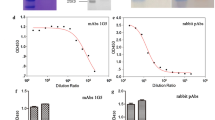Abstract
Triatoma virus (TrV) is the only entomopathogenic virus found in triatomines. TrV replicates in cells of the midgut epithelium of triatomines, causing a high mortality rate and delayed development of the infected insect. In this work, we report an antigen-capture enzyme-linked immunosorbent assay (AC-ELISA) and a reverse transcription-polymerase chain reaction (RT-PCR) assay for detection of TrV infection. For antiserum production, rabbits and hens where inoculated with purified TrV. Antiserum reactivity was checked by immunodiffusion, and its specificity was confirmed by western blot and AC-ELISA. Totally 90 fecal samples from T. infestans were analysed. AC-ELISA and RT-PCR results correlated well with transmission electron microscopy (EM) observations, which are considered the gold standard, with Kappa values of 0.73 for AC-ELISA and 0.93 for RT-PCR when compared with EM. Applications and complementary uses of the two techniques reported in this work are discussed.



Similar content being viewed by others
References
Muscio OA, La Torre JL, Scodeller EA (1987) Small nonoccluded viruses from triatomine bug Triatoma infestans (Hemiptera: Reduviidae). J Invertebr Pathol 9:218–220
Muscio OA, La Torre JL, Scodeller EA (1988) Characterization of Triatoma virus, a picorna-like virus isolated from the triatomine bug Triatoma infestans. J Gen Virol 69:2929–2934
Czibener C, La Torre JL, Muscio OA et al (2000) Nucleotide sequence analysis of Triatoma virus shows that it is a member of a novel group of insect RNA viruses. J Gen Virol 81:1149–1154
Mayo MA (2002) A summary of taxonomic changes recently approved by ICTV. Arch Virol 147:1655–1663
Muscio OA, La Torre JL, Bonder MA et al (1997) Triatoma virus pathogenicity in laboratory colonies of Triatoma infestans (Hemiptera: Reduviidae). J Med Entomol 34:253–256
Rozas-Dennis GS, Cazzaniga NJ (2000) Effects of Triatoma virus (TrV) in the fecundity and moulting of Triatoma infestans (Hemiptera reduviidae). Ann Trop Med Parasitol 94:633–644
Muscio OA, Bonder MA, La Torre JL et al (2000) Horizontal transmission of Triatoma virus through the fecal-oral route in Triatoma infestans (Hemiptera: Triatomidae). J Med Entomol 37:271–275
Remme JHF, Feenstra P, Lever PR et al (2006) Tropical diseases targeted for elimination: Chagas disease, lymphatic filariasis, onchocerciasis and leprosy. In: Disease control priorities in developing countries, 2nd edn. World Bank/Oxford University Press, Washington, pp 433–449
Segura EL, Cura EN, Sosa Estan SA et al (2000) Long-term effects of a nationwide control program on the seropositivity for Trypanosoma cruzi infection in young men from Argentina. Am J Trop Med Hyg 62:353–362
Ryckman RE, Blankenship CM (1984) The parasites, predators and symbionts of the Triatominae (Hemiptera: Reduviidae: Triatominae). Bull Soc Vector Ecol 9:84–111
Weiser J (1991) Biological control of vectors. Wiley, Chichester, pp 1–189
Rozas-Dennis GS, Cazzaniga NJ, Guerin DMA (2002) Triatoma patagonica (Hemiptera, Reduviidae), a new host for Triatoma virus. Mem Inst Oswaldo Cruz 97:427–429
Laemmli V (1970) Cleavage and structural proteins during the assembly of the head of bacteriophage T4. Nature 227:680–685
IAEA (1988) Use of enzyme-linked immunosorbent assay (ELISA) in animal disease diagnosis. IAEA, Vienna
Rozas-Dennis GS, La Torre JL, Muscio OA et al (2000) Direct methods for detecting picorna-like virus from dead and alive triatomine insects. Mem Inst Oswaldo Cruz 95:323–327
Marti GA (2005) Parásitos, patógenos y flora intestinal de triatominos (Hemiptera:Reduviidae) de la Argentina, con énfasis en Triatoma infestans (Klug), Doctoral Thesis, Facultadad de Ciencias Naturales y Museo, Universidad Nacional de La Plata, p 136
Hung ACF, Shimanuki HA (1999) Scientific note on the detection of Kashmir bee virus in individual honey bees and Varroa jacobsoni mites. Apidologie 30:353–354
Johnson KN, Christian PD (1999) Molecular characterization of Drosophila C virus isolates. J Invertebr Pathol 73:248–254
Samuel PP, Tyagi BK (2006) Diagnostic methods for detection and isolation of dengue virus from vector mosquitoes. Indian J Med Res 123:615–628
Stevens M, Hull R, Smith HG (1997) Comparison of ELISA and RT-PCR for the detection of beet yellows closterovirus in plants and aphids. J Virol Methods 68:9–16
Chungue E, Roche C, Lefevre MF et al (1993) Ultra-rapid, simple, sensitive, and economical silica method for extraction of dengue viral RNA from clinical specimens and mosquitoes by reverse transcriptase-polymerase chain reaction. J Med Virol 40:142–145
Gajanana A, Rajendran R, Thenmozhi V et al (1995) Comparative evaluation of bioassay and ELISA for detection of Japanese encephalitis virus in field collected mosquitoes. Southeast Asian J Trop Med Public Health 26:91–97
Gajanana A, Rajendran R, Philip Samuel P et al (1997) Japanese encephalitis in South Arcot District, Tamil Nadu, India: a three-year longitudinal study of vector abundance and infection frequency. J Med Entomol 34:651–659
Tewari SC, Thenmozhi V, Katholi CR et al (2004) Dengue vector prevalence and virus infection in a rural area in South India. Trop Med Int Health 4:499–507
Acknowledgments
GAM thanks the staff of Cátedra de Virología, FCV-UNLP, and the Programa de Movilidad de Profesores de la UPV/EHU. During this work, DMAG was a visiting professor of the UPV/EHU. JJG is a Researcher of the CICPBA; MGE is a Researcher of the CONICET. This study was partially supported by CONICET and Agencia Nacional de Promoción Científica y Tecnológicas, Argentina (PICT No 32618/05). We are very gratefully to Dr Eduardo Mórtola FCV-UNLP and Dr Félix Goñi (CSIC-UPV/EHU) for valuable comments on a draft of this manuscript. We are indebted to Lic G. Rozas-Dennis (UNS, Bahía Blanca, Argentina) for providing TrV-free insects and triatomine feces for AC-ELISA and RT-PCR analyses.
Author information
Authors and Affiliations
Corresponding authors
Rights and permissions
About this article
Cite this article
Marti, G.A., González, E.T., García, J.J. et al. AC-ELISA and RT-PCR assays for the diagnosis of triatoma virus (TrV) in triatomines (Hemiptera: Reduviidae) species. Arch Virol 153, 1427–1432 (2008). https://doi.org/10.1007/s00705-008-0130-x
Received:
Accepted:
Published:
Issue Date:
DOI: https://doi.org/10.1007/s00705-008-0130-x




